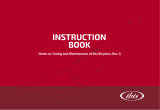
Tipp: Scan to follow along with Pivot
Factory Racing star Bernard Kerr as he
shows you how to set up sag.
Assistance, Terms, Tools and Pivot Particularities
For your Pivot suspension equipped bike to pedal and descend at its best,
it is important to tune the suspension properly. Use this guide to familiarize
yourself with the Pivot suspension setup procedures and as a baseline for
tuning to your individual riding needs.
In this setup guide, a few terms come up, that we want to briefly explain:
Sag: Sag is measured in millimeters or given as a percentage of the overall travel. Sag describes how far your bike will
compress under your weight, when the bike is at rest.
Click: Dials on suspension usually feature an indication, that you can feel or hear, when turning the dial.
Rebound: Rebound controlls how fast your fork or shock extend after being compressed. Rebound dials on all Fox and Marzocchi
suspension are red. The fully open position can be reached by turning counter clockwise or to "–". Adjust to the fully
closed position by turning the dial clockwise or to "+".
Compression: Compression controlls how firm the fork or shock will react to bumps or weight shifts. Compression dials are blue and
black for all Fox products and either way golden or black for Marzocchi suspension. The fully open position can be
reached by turning counter clockwise or to "–". Adjust to the fully closed position by turning the dial clockwise or to "+"
or "FIRM".
Low-Speed: Low speed damping works for loads that result in low shaft speeds at compression or extension, like weight shifts.
High-Speed: High speed damping works for loads that result in high shaft speeds at compression or extension, like square edged
bumps.
Tools:
To set up your suspension, you only need a few tools. Most importantly, you will need a shock pump for bike suspension to set sag.
Damping adjustments on Fox and Marzocchi forks, aswell as Fox Float DPS, Float DPX2 and Float X will not require tools. You will
need a 2 mm, 3 mm and 6 mm allen key for setting up Fox Float X2 and DHX2 shocks. To set up sag on coil shocks, you will need a tape
measure. For a spring change on coil shocks you need to take the shock off the bike. Use the dedicated tools and a bike stand.
Pivot Particularities:
Our set up guide may differ slightly from Fox's stock guidelines because our settings are calibrated in the rocky southwest terrain.
Consider these recommendations as a starting point. If you are riding on steeper terrain, or smoother trails, you may want to alter your
setup a little.
In general always follow this procedure, when adjusting your suspension:
1. Setting Sag
2. Setting Rebound
3. Setting Compression
Before setting sag, it is necessary to turn all dials to the fully open position. Pivot counts the clicks from the fully open position, because
that way, you won't need to turn all dials to the fully closed position again. This will safe some time, that you can spend riding instead.
Another reason is it is easy to damage the shock or fork adjustments when turning the adjuster all the way in. It can feel like there is an
"extra" 1/2 click that doesn't exist. This can break the adjustments and requiring service or repair. Fox suspension set up guides always
count clicks from closed.
1. General Information on Suspension Setup
www.pivotcycles.com 1.877.857.4868
SUSPENSION SETUP GUIDE
1


















